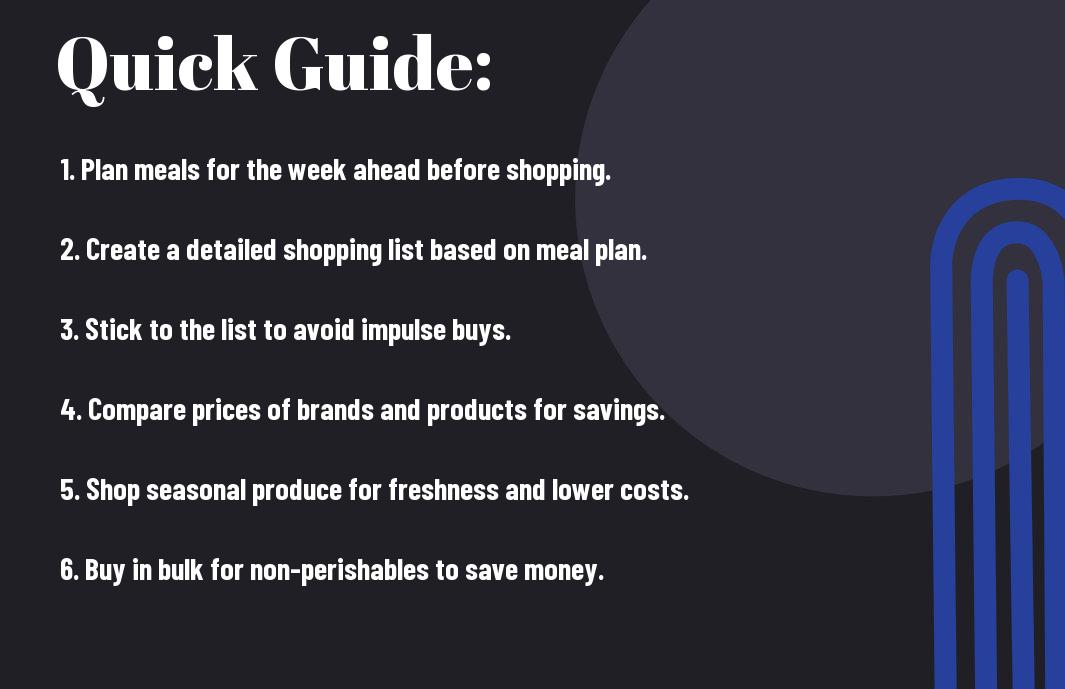Over the past few years, maintaining a healthy diet doesn’t have to break the bank. In this Budget Healthy Shopping Guide, you will discover practical tips and strategies that empower you to make nutritious choices without overspending. From planning your meals and creating a shopping list to understanding food labels, you will gain insights that help you stretch your grocery budget while prioritizing your health. Let’s look into how you can eat well and save money at the same time!

Key Takeaways:
- Plan Meals: Create a weekly meal plan to avoid impulse purchases and stick to healthy options.
- Shop Seasonally: Choose seasonal fruits and vegetables for better prices and freshness.
- Compare Prices: Use unit pricing to find the best deals between different brands and sizes.
- Buy in Bulk: Purchase non-perishable items in bulk to save money over time.
- Limit Processed Foods: Focus on whole foods to reduce costs and improve nutritional quality.
- Utilize Coupons: Take advantage of coupons and discounts to maximize savings.
- Store Brands: Opt for store brands instead of name brands for similar quality at lower prices.
Understanding Different Types of Healthy Foods
Before you start your healthy shopping journey, it’s crucial to understand the different types of foods that can contribute to your well-being. Focus on incorporating a variety of nutrient-dense options to ensure you are providing your body with all it needs. Here’s a quick breakdown:
| Type of Food | Description |
| Fresh Produce | Nutrient-rich fruits and vegetables. |
| Whole Grains | Unrefined grains packed with fiber. |
| Lean Proteins | Low-fat sources of protein. |
| Healthy Fats | Beneficial fats from natural sources. |
| Processed Foods | Foods with additives that may be less healthy. |
Assume that by diversifying your shopping cart with these food types, you will effectively support your body’s nutritional needs.
Fresh Produce
Produce forms the foundation of a healthy diet, offering vitamins, minerals, and antioxidants. Aim to fill your cart with colorful fruits and vegetables, which can enhance not only your meals but also your health.
Whole Grains
For a well-rounded diet, whole grains are a fantastic addition. They are unrefined and retain their natural nutrients, providing crucial fiber that aids digestion and keeps you full longer.
To incorporate whole grains into your diet, consider options such as quinoa, brown rice, and whole-wheat bread. These options not only supply energy but also contribute to heart health and weight management due to their fiber content.
Lean Proteins
Proteins play a vital role in your body by building and repairing tissues. Opt for lean protein sources like chicken, fish, beans, and legumes to fuel your body effectively without excess fat.
Grains, including legumes like lentils and chickpeas, can also serve as excellent plant-based protein options, ensuring you receive adequate amounts while supporting your overall health.
Healthy Fats
Healthy fats are beneficial for your body and can be found in foods such as avocados, nuts, and olive oil. These fats support brain function and heart health.
The inclusion of healthy fats in your diet can help you feel satiated and reduce cravings when included in balanced meals, making them integral to a healthy eating strategy.

Tips for Budget-Friendly Healthy Shopping
Despite the perception that healthy eating can be expensive, you can make it work on a budget with some handy strategies:
- Plan your meals for the week
- Shop seasonal produce
- Use coupons and take advantage of sales
- Buy in bulk when possible
- Opt for store brands
Recognizing these strategies can significantly reduce your grocery bill while still meeting your health goals.
Meal Planning
While organizing your weekly meals might seem time-consuming, it can save you both money and stress. By planning your meals ahead of time, you can make a comprehensive shopping list that minimizes impulse purchases and helps you focus on nutritious ingredients.
Seasonal Purchases
Planning your meals around seasonal produce is a smart way to save money and enhance the freshness of your food choices.
Understanding how to choose ingredients based on the season will not only cut costs but also improve the flavor of your meals. Seasonal fruits and vegetables are often more abundant, leading to lower prices. Additionally, they are usually harvested at their peak ripeness, ensuring optimal taste and nutrition. By incorporating seasonal items into your meal plan, you support local farmers and enjoy a more varied diet throughout the year.
Utilize Coupons and Sales
On a budget, finding and using coupons can significantly reduce your grocery expenses while still allowing you to choose healthy options.
The key to maximizing savings through coupons is to stay organized and plan. Begin by checking your local grocery store’s weekly ad for specials and match those with available coupons. Consider using digital coupons through grocery apps or websites, which can often provide additional discounts. By combining your meal planning with couponing, you ensure that your purchases align with your health goals while being cost-effective.

Step-by-Step Guide to Shopping on a Budget
To maximize your savings while grocery shopping, follow these simple steps. First, set a budget based on your income and expenses. Next, create a shopping list and stick to it. As you shop, keep an eye out for sales and utilize coupons. Finally, assess your purchases at the checkout to ensure they align with your budget.
Creating a Shopping List
Creating a Shopping List
On a budget, a detailed shopping list is your best friend. It helps you stay focused and reduces impulse buys. Take time to plan your meals for the week, allowing you to identify specific items you need. Additionally, organize your list by category, such as produce, dairy, or grains, to make your shopping trip more efficient.
Navigating the Grocery Store
Navigating the Grocery Store
For an efficient shopping experience, familiarize yourself with the layout of your grocery store. This can help you quickly locate the items on your list and avoid wandering into aisles that may encourage unplanned purchases. Visit the store during less crowded times to make your trip smoother and more enjoyable.
To further optimize your grocery shopping, consider shopping the perimeter of the store first, where fresh produce, meats, and dairy are typically located. This may help you prioritize healthier options before venturing into the middle aisles, where processed goods tend to be located. Keeping a keen eye on signage and sales can also help you uncover discounts.
Sticking to Your Budget
Sticking to Your Budget
Even as you navigate through the store, it’s imperative to stick to your budget. Monitor your spending by keeping a running total of your cart. This proactive approach ensures you stay within your allocated amount and can adjust your purchases if you exceed your budget.
Sticking to your budget requires self-discipline and awareness of your spending habits. A good strategy is to use cash instead of cards—once your budget is used up, you’ll need to stop shopping. Have a firm commitment to avoid temptations, and consider shopping alone to minimize distractions from others. By staying focused, you can successfully achieve your budget goals while shopping for healthy options.
Key Factors to Consider While Shopping
Now, when shopping for healthy items on a budget, consider these key factors to maximize your efforts:
- Nutritional Value
- Pricing
- Portion Sizes
Knowing how to balance these factors will ensure that you maintain a healthy diet without emptying your wallet. For more insights, check out 19 Cheap & Healthy Grocery List Tips & Tricks – How to Shop Smart.
Nutritional Value
Factors such as vitamins, minerals, and overall health benefits should guide your grocery selections. Look for whole foods that are rich in nutrients, aiming to fill your cart with colorful fruits and vegetables that provide necessary benefits.
Pricing
Shopping with price in mind allows you to find deals while still prioritizing your health goals. Compare prices on similar items to find the best value, and consider buying store brands that offer quality products at a lower cost.
A key strategy to save on pricing is to plan your meals according to what’s on sale or in season. Create a shopping list based on discounts while adhering to nutritional guidelines, allowing you to prepare diverse and healthy meals at home.
Portion Sizes
Even when selecting healthy options, be conscious of portion sizes to avoid waste and overspending. Adjusting your portions can help manage both variables effectively.
The more you understand portion sizes, the better equipped you will be to choose products that match your dietary needs without purchasing excess food. This mindful eating approach will ultimately support your health while being budget-friendly.

Pros and Cons of Healthy Shopping on a Budget
Unlike what many believe, healthy shopping on a budget comes with its own set of advantages and disadvantages. Understanding these can help you make informed decisions about your grocery habits. Here’s a breakdown in the table below:
| Pros | Cons |
|---|---|
| Helps you save money. | Limited product selection. |
| Encourages meal planning. | More time-consuming to prepare meals. |
| Promotes healthier eating habits. | Higher initial investment in quality items. |
| Reduces impulse buying. | Potential for lower satisfaction with taste. |
| Encourages seasonal and local purchases. | May require sourcing multiple stores. |
If you want to dive deeper, check out the Eat Smart, Spend Less: Guide to a Budget Friendly Healthy Grocery Haul.
Advantages
The benefits of healthy shopping on a budget include substantial cost savings, healthier eating patterns, and increased awareness of what you consume. You’ll often find that meal planning helps you to not only stick to your budget but also reduces food waste and the temptation to splurge on unhealthy snacks.
Disadvantages
Pros of healthy shopping on a budget can include time constraints and the challenge of finding high-quality products. You may find yourself needing to adjust your shopping habits, which could lead to frustrations when searching for specific items.
Another drawback you might encounter is that budget-friendly options can sometimes compromise on taste or quality. You may discover that not all affordable health foods meet your expectations, requiring you to be more selective and creative in your meal preparation.
Final Words
From above, you’ve learned that budgeting for healthy shopping doesn’t have to be overwhelming. By planning your meals, creating a shopping list, and prioritizing whole foods, you can make informed choices that support your wellbeing while being kind to your wallet. Utilizing seasonal produce and exploring local markets can further stretch your budget without sacrificing nutrition. With these strategies in hand, you are well-equipped to enjoy a healthier lifestyle that fits your financial plans, ensuring that smart shopping becomes a sustainable practice in your daily routine.
FAQ
Q: What makes a shopping guide for healthy food budget-friendly?
A: A budget healthy shopping guide focuses on maximizing nutritional value while minimizing expenses. It includes tips for selecting affordable whole foods, planning meals, and utilizing seasonal produce to lower costs. Additionally, it emphasizes bulk buying and the use of coupons or discounts to save money.
Q: How can I create a grocery list that aligns with a healthy budget?
A: To create a budget-friendly grocery list, start by planning your meals for the week. List the ingredients you need, focusing on whole foods such as fruits, vegetables, legumes, and grains. Organize your list by categories, prioritize items on sale, and consider cost-effective protein sources like beans and lentils. This way, you can stick to your budget while making healthy choices.
Q: Are there specific stores that tend to have healthier products at lower prices?
A: Many budget-friendly stores, such as discount grocers or warehouse clubs, offer healthy options at competitive prices. Local farmers’ markets can also be a great source for fresh produce at lower rates. Additionally, health-focused supermarkets may have sales and promotions on organic or natural products, making them more affordable when planned accordingly.
Q: How can I avoid waste when shopping on a budget and aiming for healthy choices?
A: To reduce waste, plan your meals carefully and buy only what you need. Store perishable items properly to extend their shelf life, and incorporate leftovers into new meals. You can also freeze extra portions for later use. By doing so, you maximize your food budget while minimizing waste and ensuring you have healthy options on hand.
Q: What role do seasonal foods play in a budget healthy shopping guide?
A: Seasonal foods are typically cheaper and taste better, as they are locally sourced and abundant. When fruits and vegetables are in season, they are more affordable and nutritious. Planning your meals around these items not only saves money but also encourages a varied and wholesome diet throughout the year.
Q: How can meal prepping contribute to both health and budget efficiency?
A: Meal prepping helps streamline the cooking process, save time, and reduce impulse purchases. By preparing meals in advance, you can portion out healthy ingredients, avoid last-minute takeout, and stick to your grocery list. This practice promotes better nutrition and can significantly lower your weekly food expenses.
Q: Are there specific cheap healthy recipes I can follow when shopping on a budget?
A: There are numerous affordable healthy recipes that utilize cost-effective ingredients. Dishes like vegetable stir-fries, bean chili, lentil soup, and whole grain pasta salads are budget-friendly options. Websites and cookbooks focused on budget cooking often provide recipes that emphasize healthy ingredients without breaking the bank. Explore these resources for inspiration tailored to your taste and budget.



